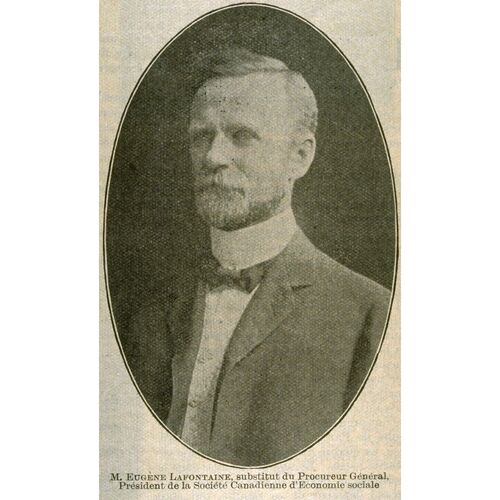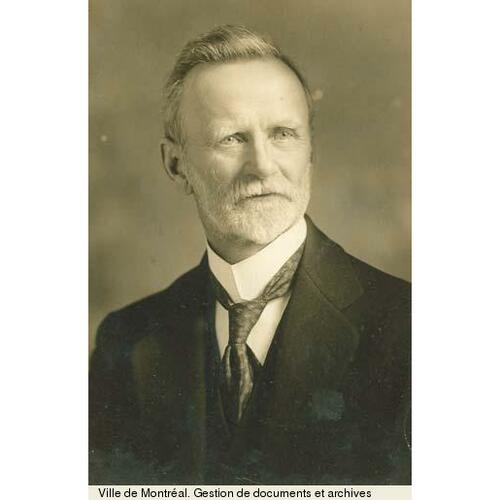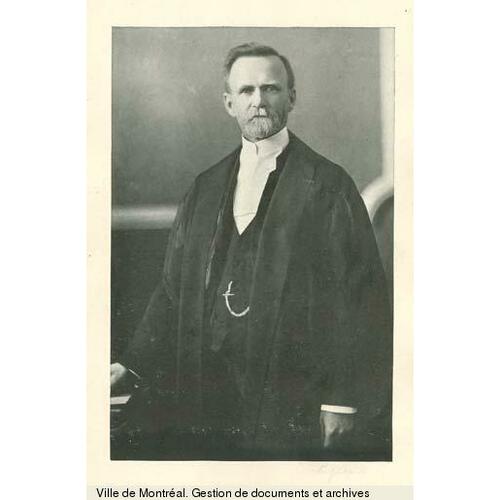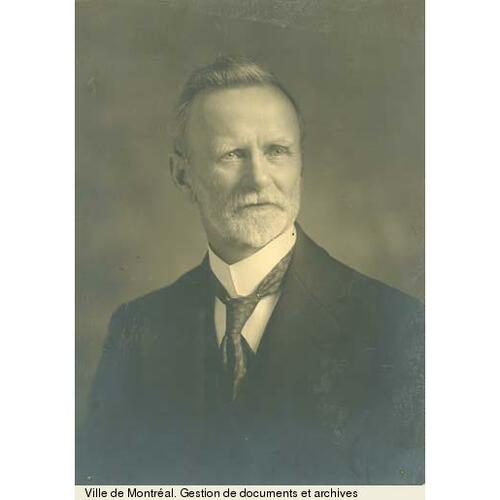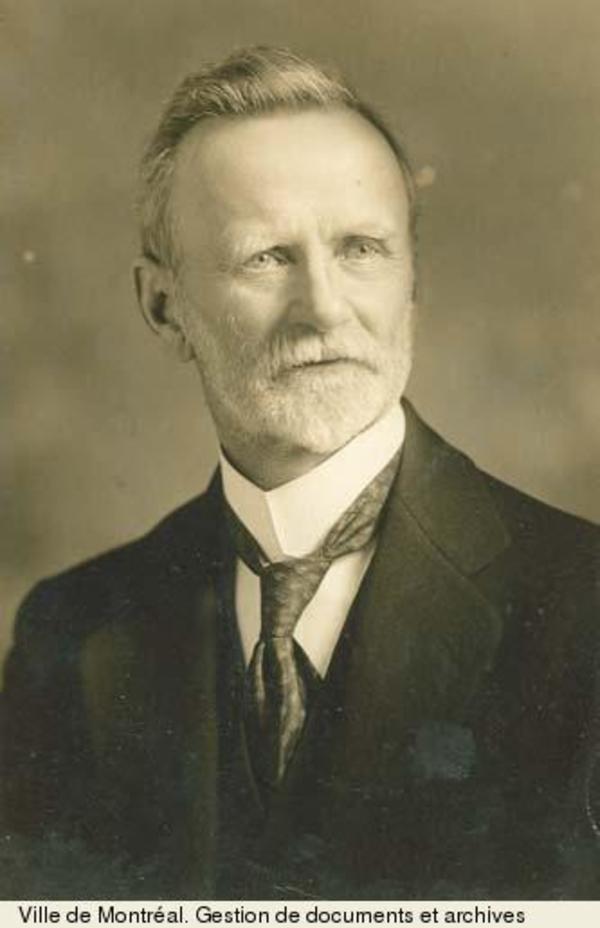
Source: Link
LAFONTAINE, PIERRE-EUGÈNE (he also signed Eugène), lawyer, politician, professor, and judge; b. 26 Nov. 1857 at Saint-Édouard, Lower Canada, son of Laurent-David Lafontaine, a physician, and Hedwige Singer; m. 14 Jan. 1880 Elmire Moll (d. 15 Feb. 1919) in Montreal, and they had a daughter; d. 21 April 1935 in that city and was buried there three days later in Notre-Dame-des-Neiges cemetery.
After completing his classical studies at the Petit Séminaire de Montréal (1869–76), Pierre-Eugène Lafontaine enrolled in the faculty of law at the Université Laval in Montreal, where in 1879 he obtained an llb with high honours as a member of the first graduating class. In July 1881 he was called to the bar of the province of Quebec and practised law in Montreal. Among his associates were Arthur Desjardins, Joseph-Alfred Mousseau*, Joseph-Louis Archambault, Raymond Préfontaine*, Frédéric-Ligori Béïque, and Edward L. Turgeon. He acted as deputy public prosecutor of the province and was appointed a qc in 1893.
In 1886, having been elected to the Legislative Assembly of the province of Quebec as the Parti National member for Napierville, Lafontaine took back the Liberal seat held by his father from 1870 to 1881. His political career was brief as he did not stand in the subsequent election in 1890.
As a young lawyer, in 1882 Lafontaine had defended his doctoral thesis, titled “Le Domicile,” at the Université Laval in Montreal. At that time jurists who pursued higher learning were few and far between so it is hardly surprising that he was part of the teaching staff of that institution from 1888 to 1930 (from 1920 it was called the Université de Montréal). Secretary of the law faculty from 1890 to 1914, he held the post of dean from 1918 to 1929. In his course on Roman law, which was classic in form and content, he occasionally referred to the provisions of the Civil Code for purposes of comparison.
Lafontaine espoused the doctrines of the Unions de la Paix Sociale, a movement that had been founded by the French sociologist and economist Frédéric Le Play and which Lafontaine joined in 1889. Its views were propagated by its branch in the province of Quebec, the Société Canadienne d’Économie Sociale de Montréal [see Sir Louis-Amable Jetté*], of which Lafontaine was president from 1905 to 1907. He also devoted two articles published in 1895 to industrial accidents, an issue of growing concern at the end of the 19th century. He realized that the industrial revolution had altered the role of workers and made them vulnerable to accidents. The law, however, continued to be interpreted as it always had been, requiring that workers seeking redress following an injury furnish proof that their employer was at fault. Doing so, however, could be impossible, or the injury the result of an unforeseen event, leaving the worker without compensation. Case law was sometimes sensitive to the worker’s situation, equating carelessness on the part of the employer with fault. Lafontaine observed that “current legislation is no longer in harmony with present-day needs” and concluded that reform was necessary. He supported strict liability for occupational hazard, which rejected the notion of fault and granted partial compensation to the victim. As an upholder of liberalism, he refused to subject business leaders to compulsory government insurance and instead favoured establishing optional private policies. Lafontaine’s thinking might well have inspired the industrial accidents bill proposed by Horace Archambeault* in 1904.
Lafontaine was appointed a judge of the Superior Court in 1906, and in 1922 succeeded Gustave Lamothe as chief justice of the Court of King’s Bench, a position he held until his retirement in 1932. In his legal rulings he paid close attention to the facts of the case before the court and revealed a pragmatic nature. To establish the amount of damages and interest to be awarded to a party, Lafontaine insisted on the need for itemized proof of the loss incurred. Furthermore, he favoured a strict interpretation of legislative texts, although he refrained from offering any that led to outcomes he considered unreasonable. Lafontaine sometimes based his decisions on a study of the history of legislation and even justified them by detailed references to Roman law.
Lafontaine had a keen interest in matters pertaining to schools and was appointed commissioner of the Montreal Catholic School Commission in 1907. He supported the views of the reformers who were opposed to the ideas of the commissioners appointed by the archbishopric [see Joseph-Narcisse Perrault*]. Among the reformers’ aims was the grouping of the city’s 30 or so Roman Catholic school boards into a single entity. Lafontaine took the lead in backing the demand. He also argued in favour of providing free schooling, organizing summer camps, giving girls access to education, opening kindergartens, and developing an enriched primary course of study to prepare pupils for instruction in engineering or commerce. In 1909 the provincial Liberal government of Sir Lomer Gouin*, which sought the public’s opinion on the reorganization, assigned the responsibility to Senator Raoul Dandurand*, who was appointed president of the royal commission with respect to the Catholic schools of Montreal. Lafontaine formulated the most comprehensive opinion on the subject during one of the public hearings. Even though he supported the amalgamation, he was against the election of commissioners by the public, fearing that those elected would be concerned mainly with the cost of education. The commission of inquiry relied on Lafontaine’s suggestions to put forward recommendations to merge the school boards. After overcoming some obstacles, Gouin’s government brought together the school boards of the cities of Montreal and Maisonneuve (Montreal) in 1916. The new entity, divided into four districts, each under the authority of a commission, was overseen by the central board [see Joseph-Narcisse Perrault], which was responsible for financial matters. Lafontaine became its first lay president in 1919. During his term, which ended in 1928, the managerial powers of the board increased relative to those of the district commissions. Alongside these activities, Lafontaine promoted thrift and fought against alcoholism in schools, with the aim of preparing students to become frugal and abstemious citizens. Lafontaine’s reformism reached its limits when it came up against the unionization of teaching staff and the demand for equal salaries for male and female teachers.
Like many reformers, Lafontaine was alarmed by alcoholism, which was considered a scourge of the family and society. He was a firm supporter of the Ligue Antialcoolique de Montréal and became its president. The movement not only advocated temperance but also fought to prohibit the buying and selling of alcoholic beverages. In October 1916 Lafontaine travelled to Quebec City at the head of a delegation of anti-alcohol leagues. On this occasion, in the presence of Premier Gouin and his ministers, he gave a speech in favour of a prohibition law. His activism led him to join the Dominion Prohibition Committee, of which he became president after the death of Francis Stephens Spence* in 1917. Despite his crusade, in a 1929 ruling from the bench, he refused to consider one voter’s consumption of free alcohol served during an election soirée as a wrongful act that warranted sanction.
Pierre-Eugène Lafontaine made his name in the legal community, holding several prestigious posts. He espoused the concerns of the progressive élite, and campaigned for the moral cleansing of society and for social reforms. His most significant contribution was to the field of education, believing as he did that its institutions required better management. To benefit learners in their early years, girls, and youth aspiring to study engineering and commerce, he became a champion of various initiatives to reform teaching methods and extend education beyond its traditional sphere.
Pierre-Eugène Lafontaine is the author of, among other works, “Le régime légal des accidents du travail devrait-il être modifié?” and “Comment modifier notre régime légal des accidents du travail?,” articles which appeared in La Rev. légale, nouv. sér., 1 (1895) on pages 67–80 and 409–18 respectively; Droit romain (Montréal, 1912); Date historique, 4 octobre 1916: son honneur le juge E. Lafontaine présentant les délégués des ligues antialcooliques de la province de Québec à sir Lomer Gouin et à ses collègues (n.p., [1916?]); and “L’alcool peut-il être un breuvage?,” Rev. trimestrielle canadienne (Montréal), 3 (1917–18): 373–85. He also wrote the foreword to A.‑A. Bruneau’s work Du mariage (Montréal, 1921).
BANQ-CAM, CE601-S60, 14 janv. 1880; CE604-S4, 29 nov. 1857. FD, Notre-Dame (Montréal), 24 avril 1935. Le Devoir, 22, 24 avril 1935. La Presse, 7 févr. 1919. Armstrong c. Boucher (1924), Rapports judiciaires officiels de Québec, Cour du banc du roi (Québec), 37: 194–221. F.‑J. Audet, Les juges en chef de la province de Québec, 1764–1924 (Québec, 1927). L.‑P. Audet, Histoire de l’enseignement au Québec (2v., Montréal et Toronto, 1971). Berard c. Mathieu (1929), Rapports judiciaires officiels de Québec, Cour du banc du roi, 47: 514–19. La Cité de Montréal c. Pryor (1925), Rapports judiciaires officiels de Québec, Cour du banc du roi, 39: 227–30. Corporation de Lacaille c. Lacaille (1930), Rapports judiciaires officiels de Québec, Cour du banc du roi, 49: 172–82. G[eorges] Daly, Les écoles maternelles: leur nature, leur valeur pédagogique et sociale (Montréal, 1914). Dame Boivin et Larue c. Gilbert (1925), Rapports judiciaires officiels de Québec, Cour du banc du roi, 39: 87–95. I.‑J. Deslauriers, Les cours de justice et la magistrature du Québec (2v., Québec, [1991–92]), 1: 77. Gagnon c. Tremblay (1926), Rapports judiciaires officiels de Québec, Cour du banc du roi, 41: 58–69. Robert Gagnon, Histoire de la Commission des écoles catholiques de Montréal: le développement d’un réseau d’écoles publiques en milieu urbain ([Montréal], 1996). Ruby Heap, “Urbanisation et éducation: la centralisation scolaire à Montréal au début du xxe siècle,” CHA, Hist. papers (1985): 132–55. Jean Hétu, Album souvenir, 1878–1978: centenaire de la faculté de droit de l’université de Montréal (Montréal, 1978). Histoire du catholicisme québécois, sous la dir. de Nive Voisine (2 tomes en 4v. parus, Montréal, 1984– ), tome 3, v.1 (Jean Hamelin et Nicole Gagnon, Le xxe siècle (1898–1940), 1984). Hurteau c. La Ville LaSalle (1926), Rapports judiciaires officiels de Québec, Cour du banc du roi, 41: 461–84. Martin c. Daigneault (1925), Rapports judiciaires officiels de Québec, Cour du banc du roi, 39: 374–84. Notice sur les écoles administrées par la Commission des écoles catholiques de Montréal (Montréal, 1915), 17. Antonio Perrault, Pour la défense de nos lois françaises (Montréal, [1919?]). M.‑C. Prémont, “Le dilemme leplaysien aux sources du droit social français et québécois,” in Libres propos sur les sources du droit: mélanges en l’honneur de Philippe Jestaz (Paris, 2006), 459–79; “L’œuvre sociale des juristes leplaysiens au Québec: une première loi des accidents du travail,” Les Études sociales (Paris), 135–36 (2002): 155–74. Que., National Assembly, “Quebec dictionary of parliamentary biography, from 1764 to the present”: www.assnat.qc.ca/en/membres/notices/index.html (consulted 12 Dec. 2018). Riou c. Martin (1924), Rapports judiciaires officiels de Québec, Cour du banc du roi, 36: 78–91. P.‑G. Roy, Les juges de la province de Québec. R. E. Spence, Prohibition in Canada: a memorial to Francis Stephens Spence (Toronto, 1919). Pierre Trépanier, “La Société canadienne d’économie sociale de Montréal, 1888–1911: sa fondation, ses buts et ses activités,” CHR, 67 (1968): 343–67; “La Société canadienne d’économie sociale de Montréal (1888–1911): ses membres, ses critiques et sa survie,” Social Hist. (Ottawa), 38 (1986): 299–322. Univ. Laval, Annuaire, 1883–84, 1888–89.
Cite This Article
Sylvio Normand, “LAFONTAINE, PIERRE-EUGÈNE (Eugène),” in Dictionary of Canadian Biography, vol. 16, University of Toronto/Université Laval, 2003–, accessed December 21, 2024, https://www.biographi.ca/en/bio/lafontaine_pierre_eugene_16E.html.
The citation above shows the format for footnotes and endnotes according to the Chicago manual of style (16th edition). Information to be used in other citation formats:
| Permalink: | https://www.biographi.ca/en/bio/lafontaine_pierre_eugene_16E.html |
| Author of Article: | Sylvio Normand |
| Title of Article: | LAFONTAINE, PIERRE-EUGÈNE (Eugène) |
| Publication Name: | Dictionary of Canadian Biography, vol. 16 |
| Publisher: | University of Toronto/Université Laval |
| Year of publication: | 2021 |
| Year of revision: | 2021 |
| Access Date: | December 21, 2024 |


